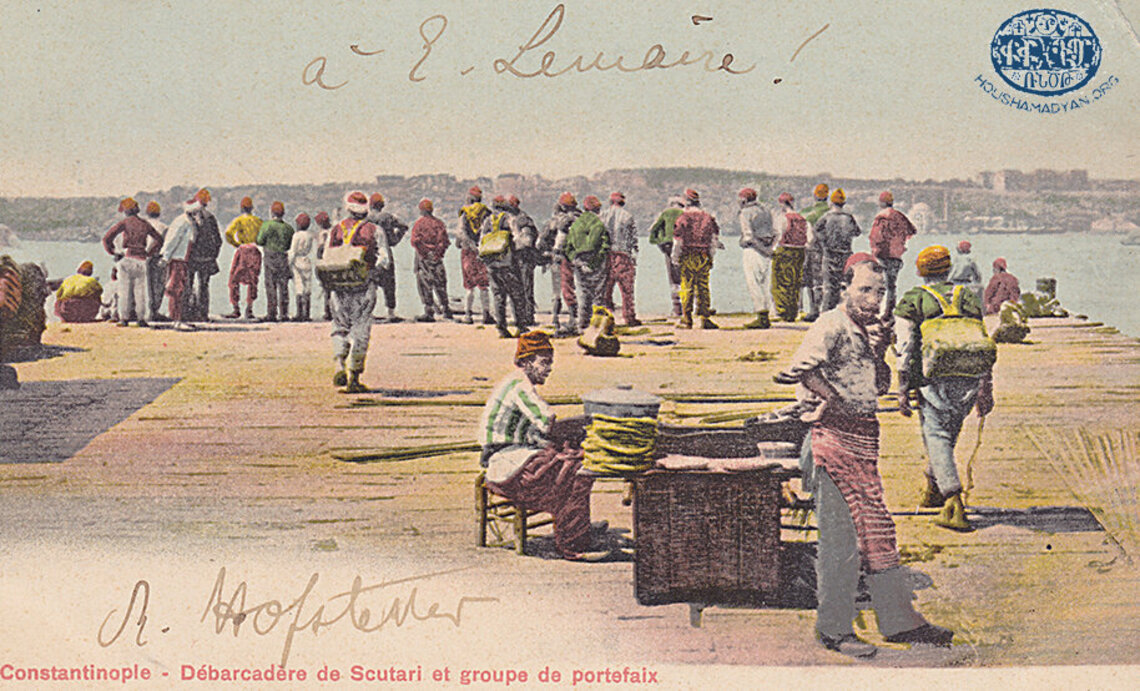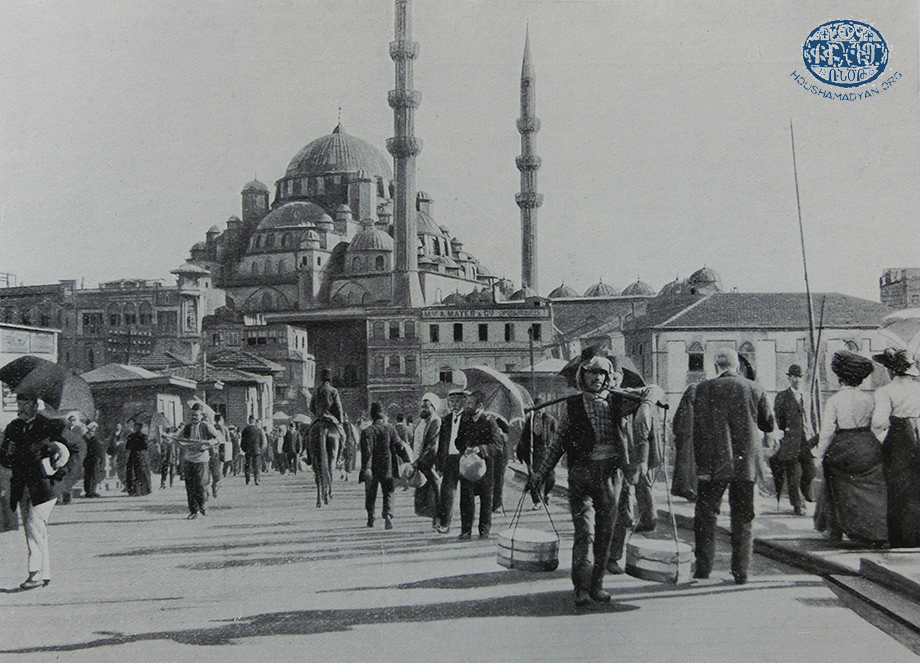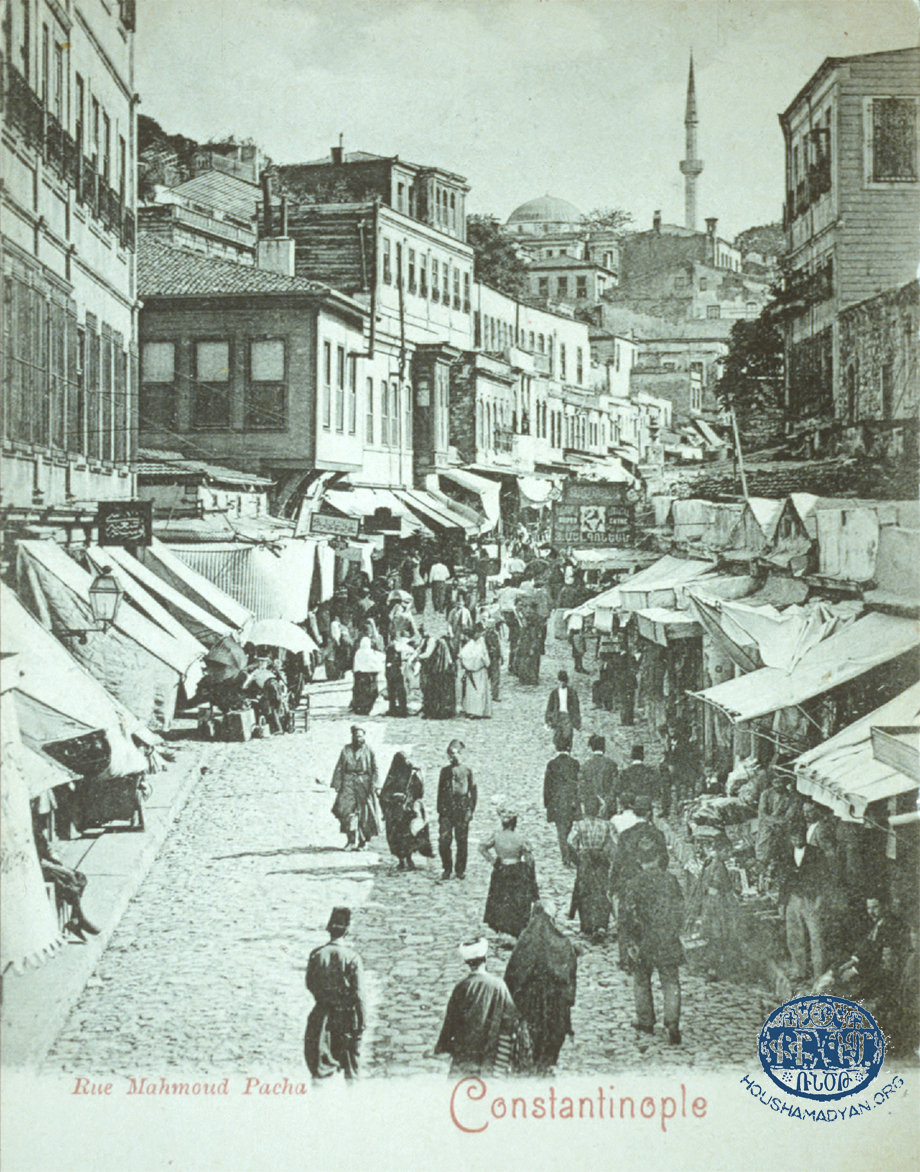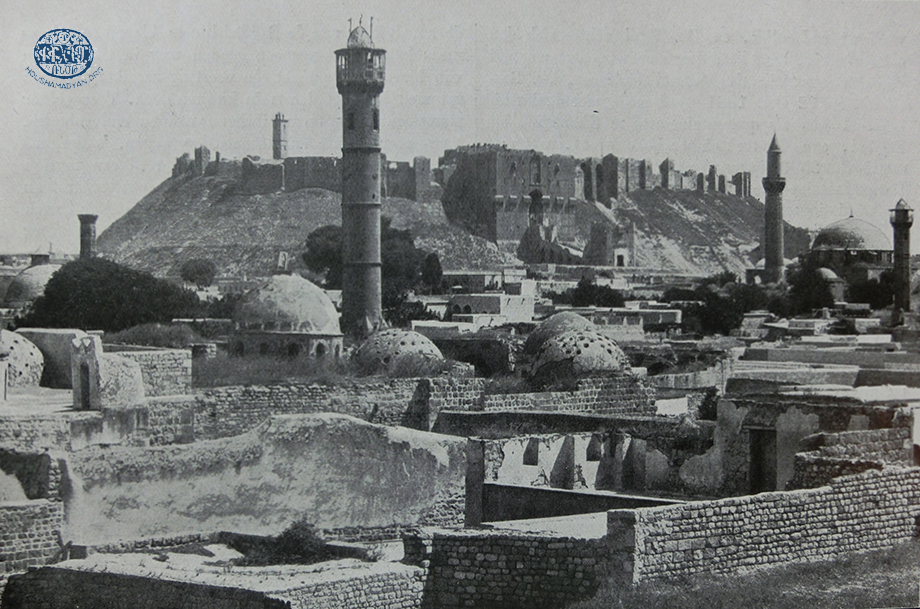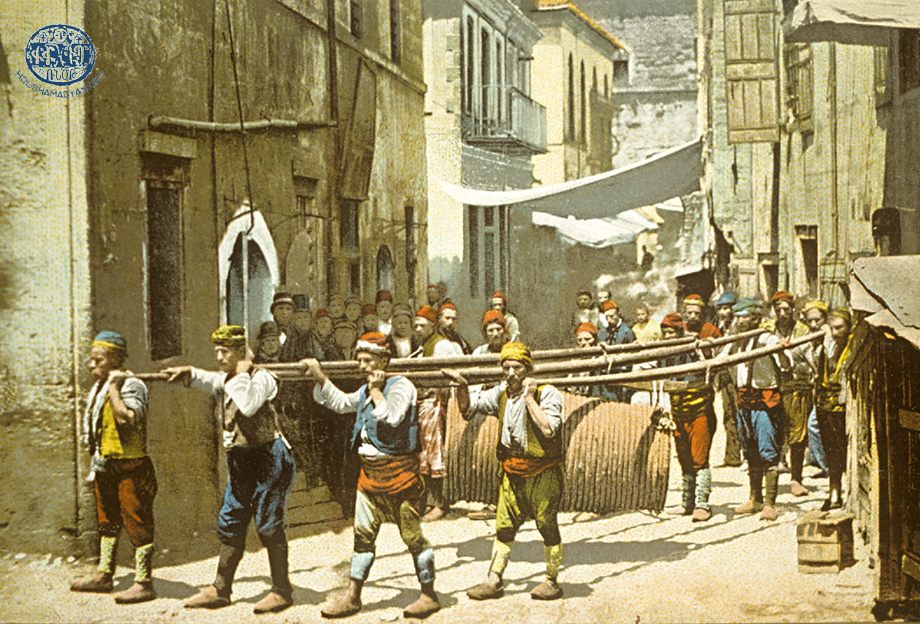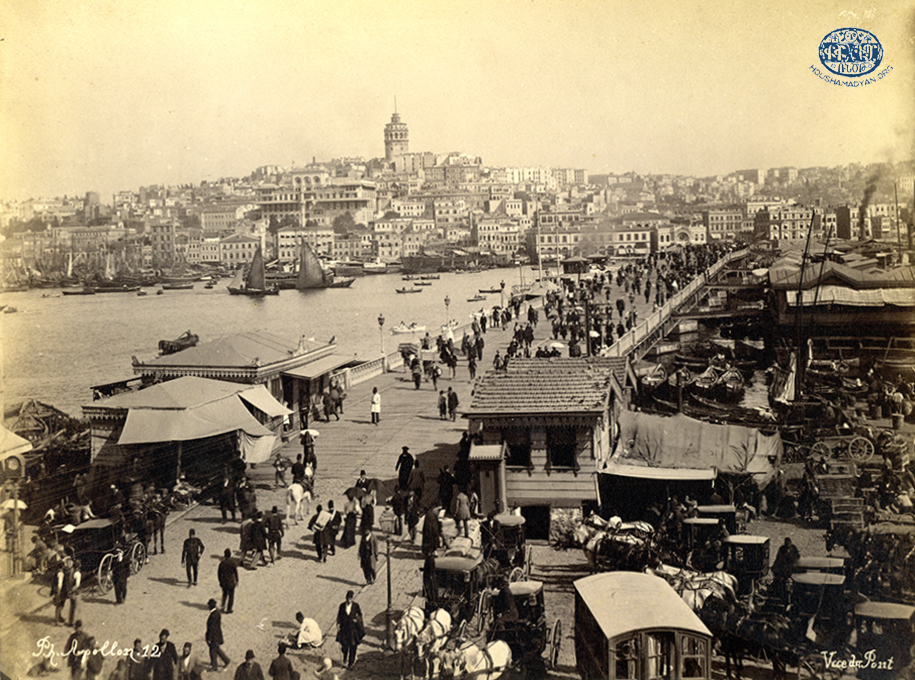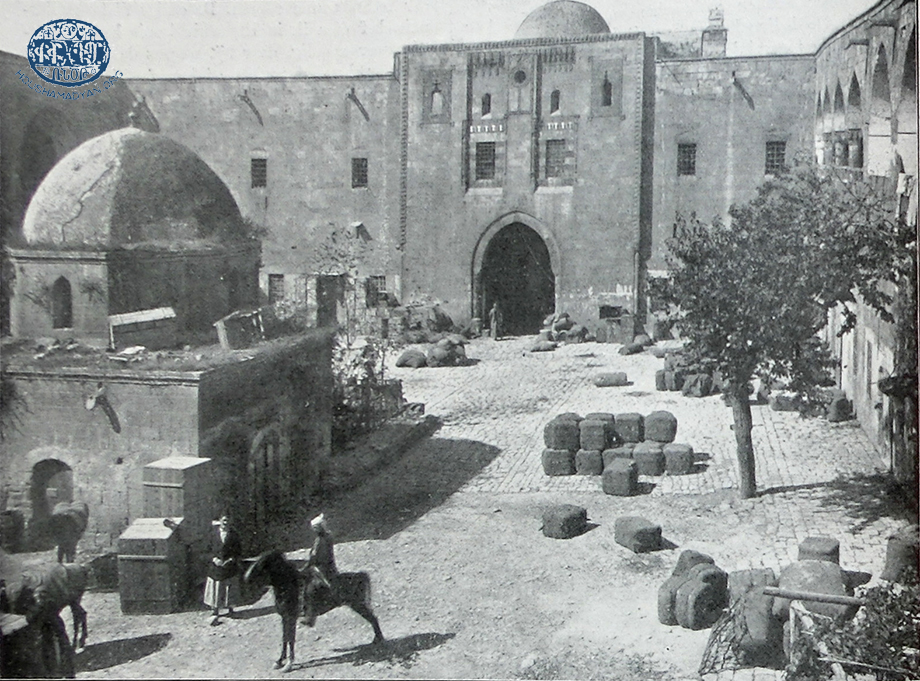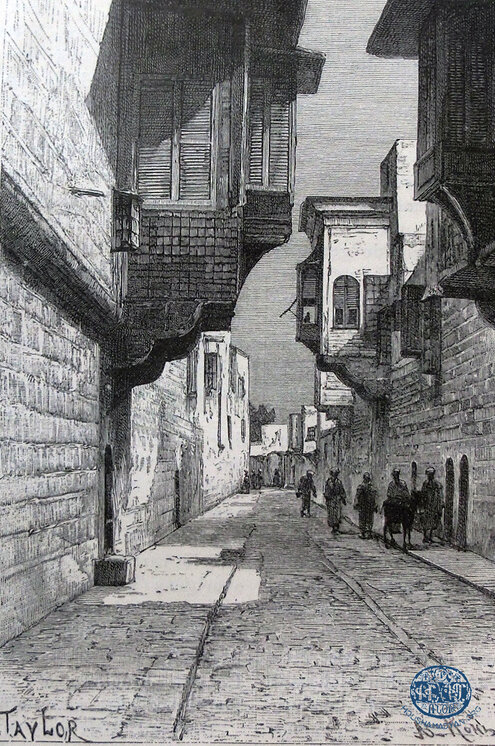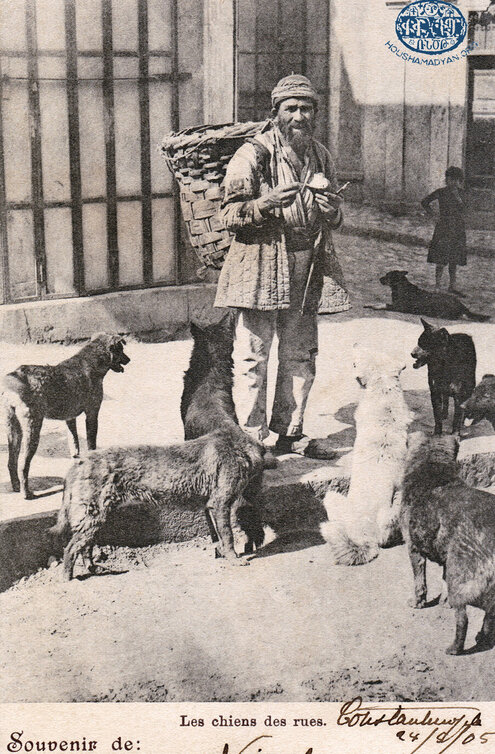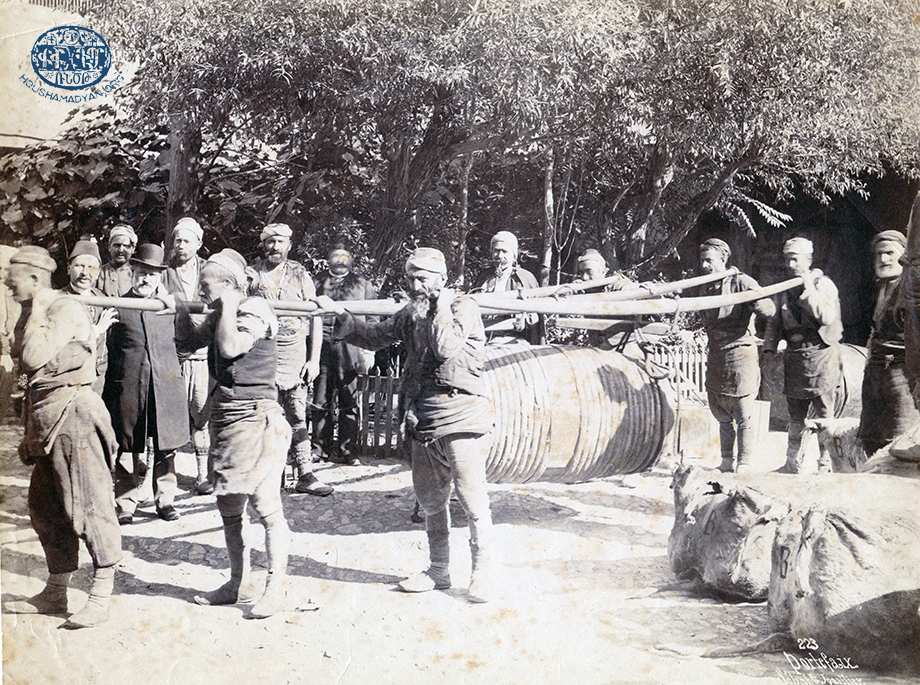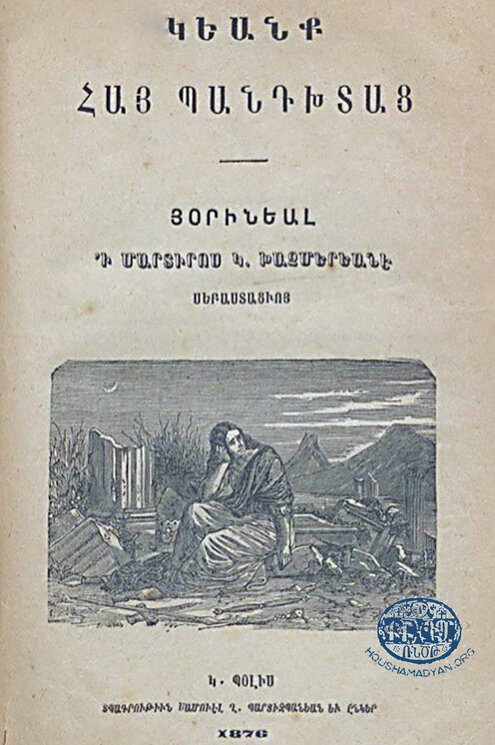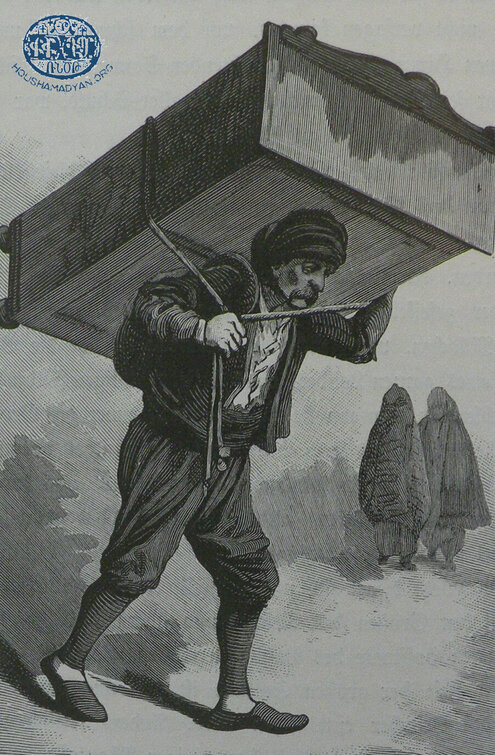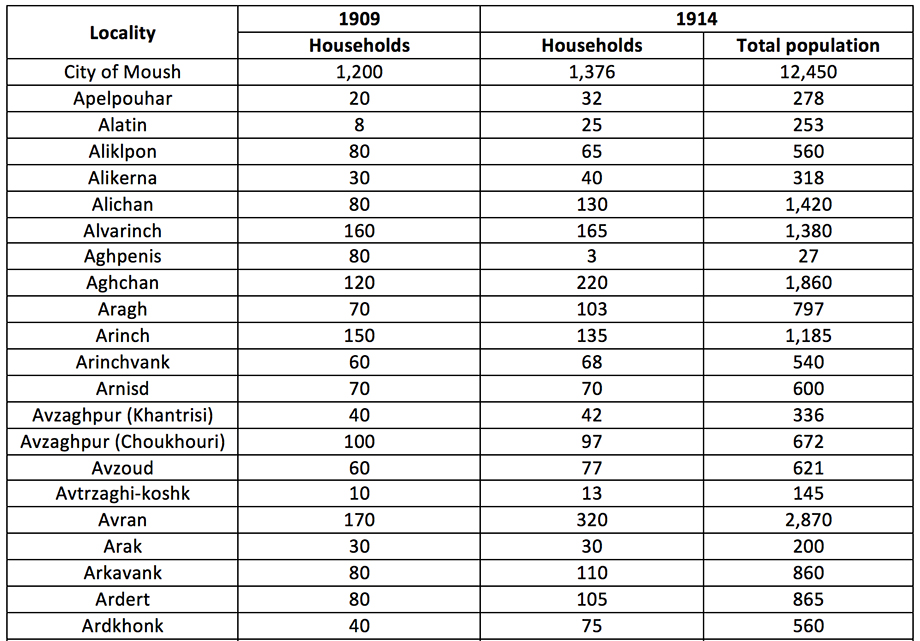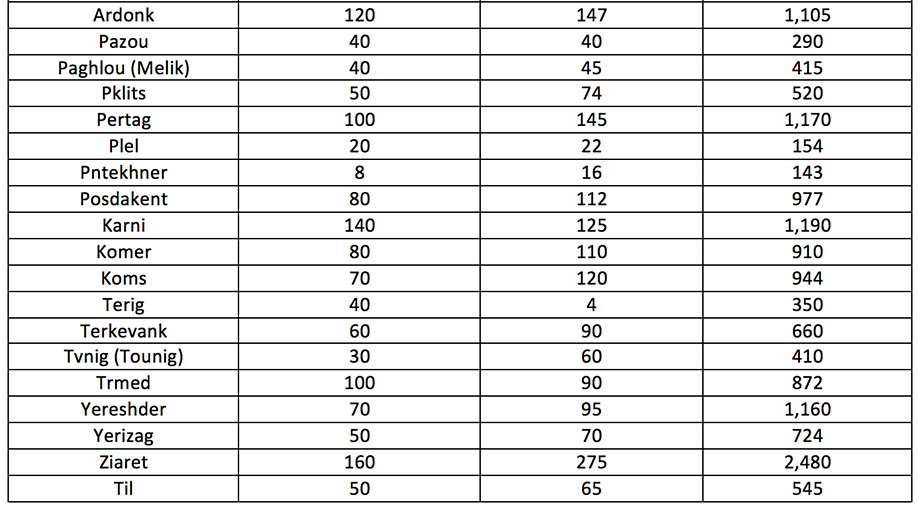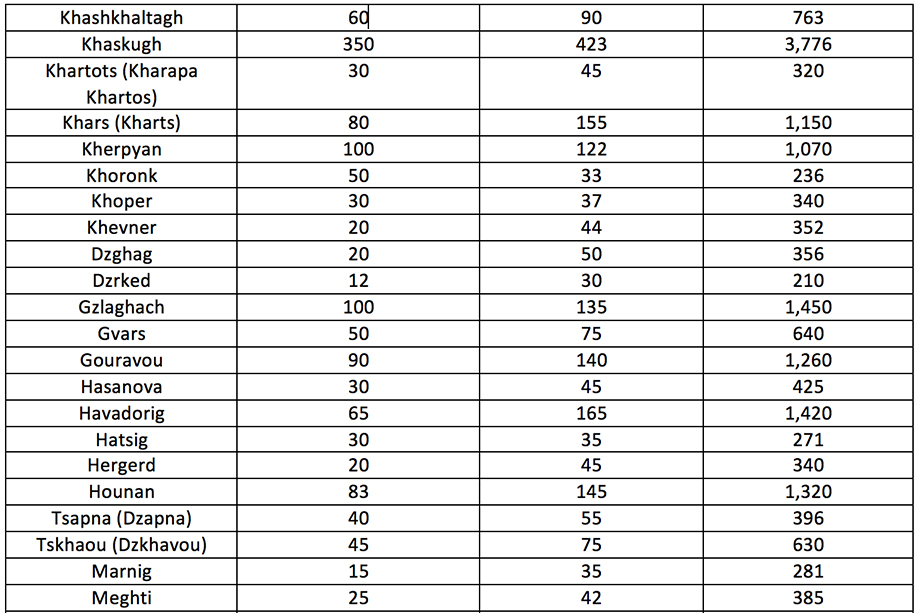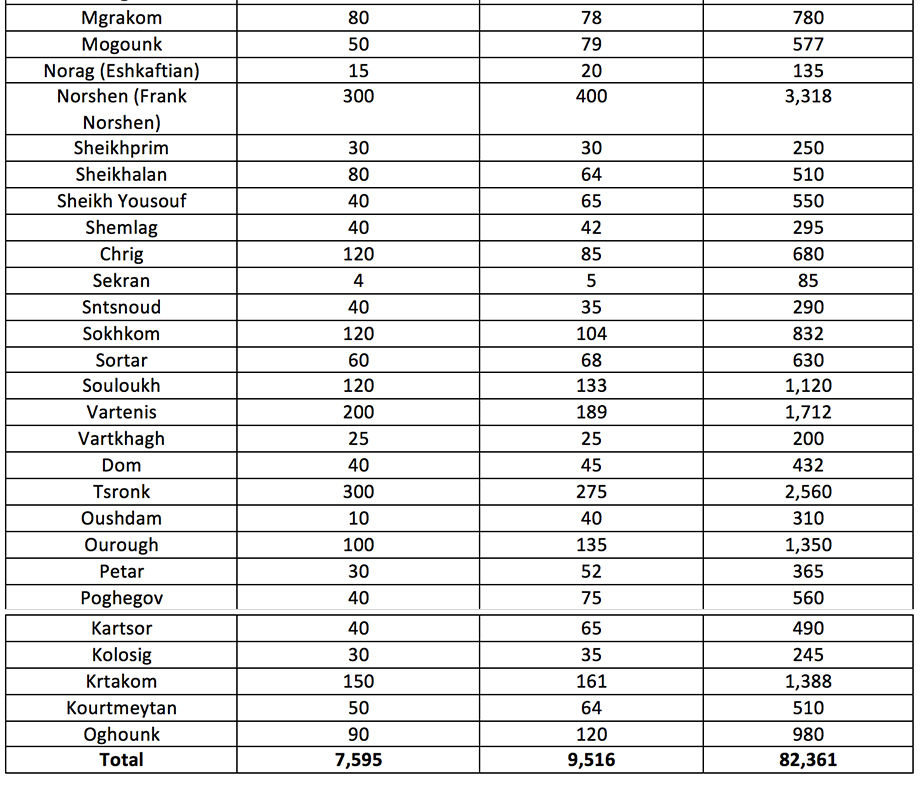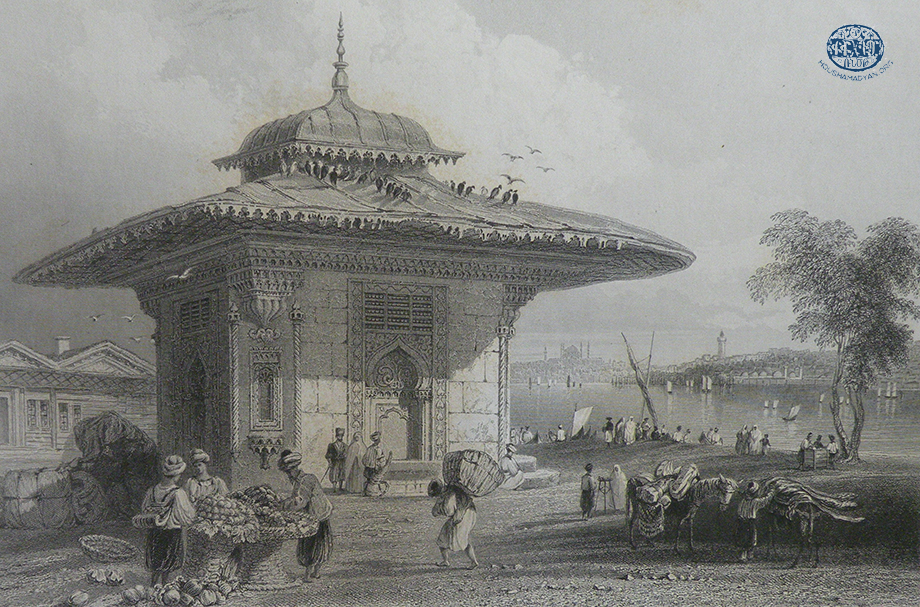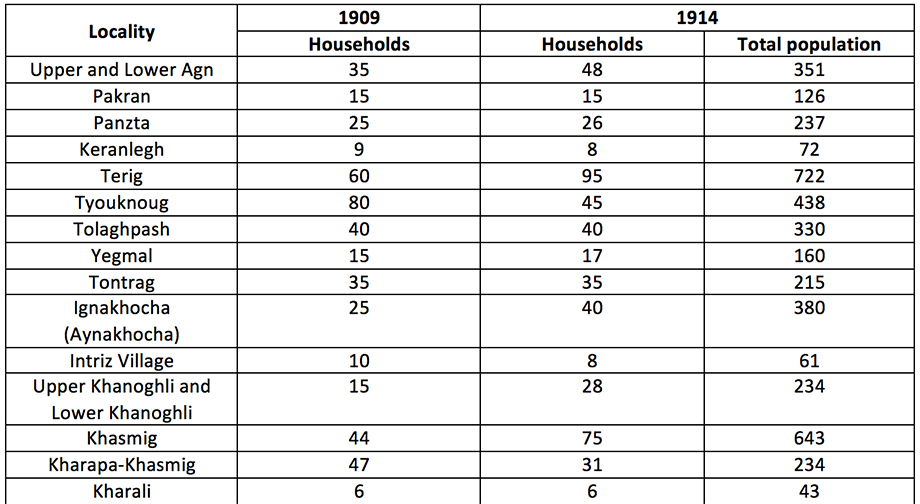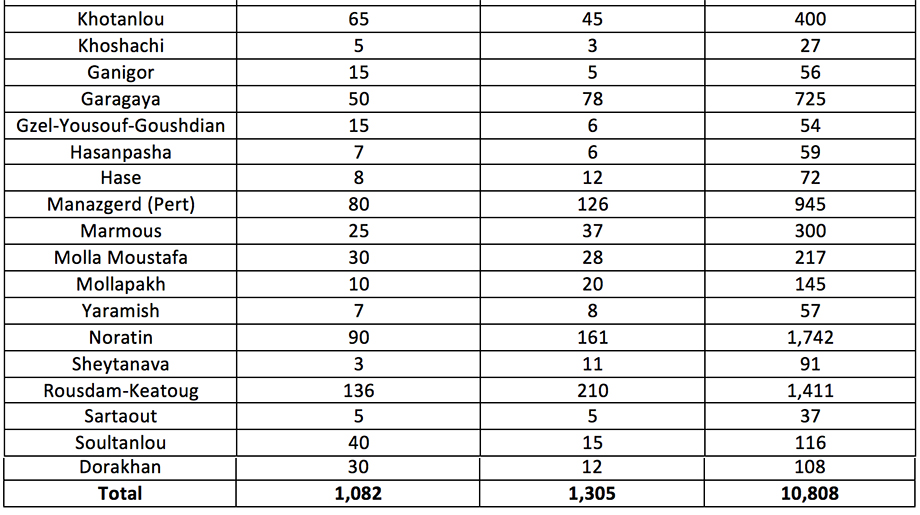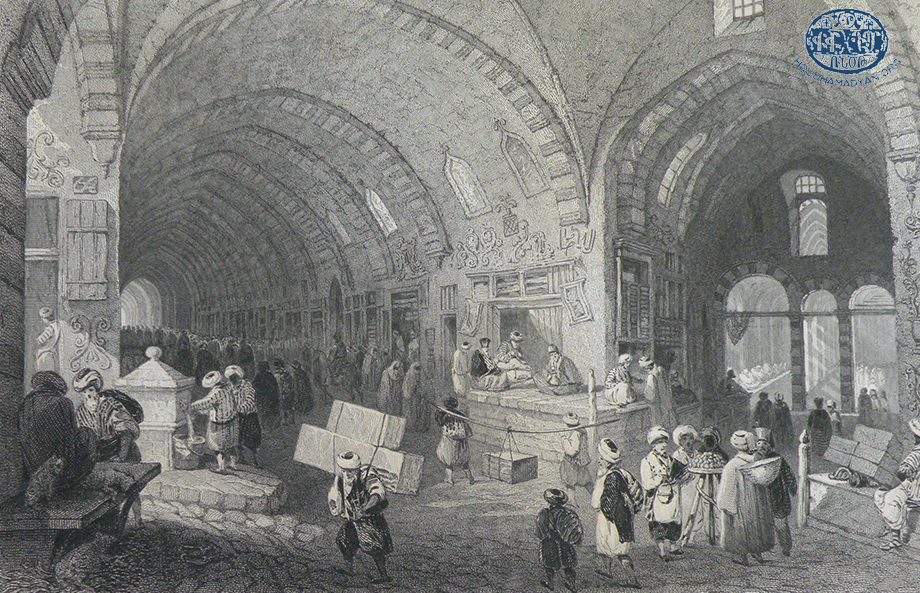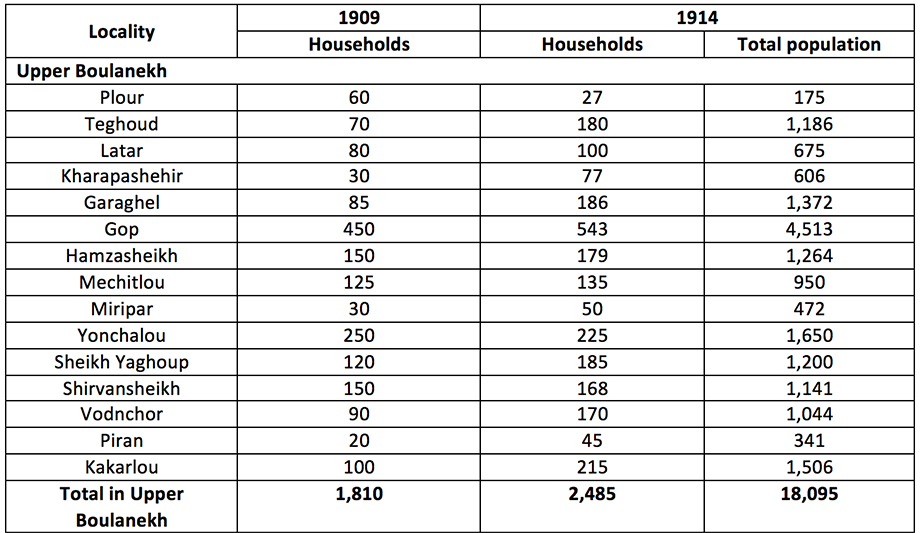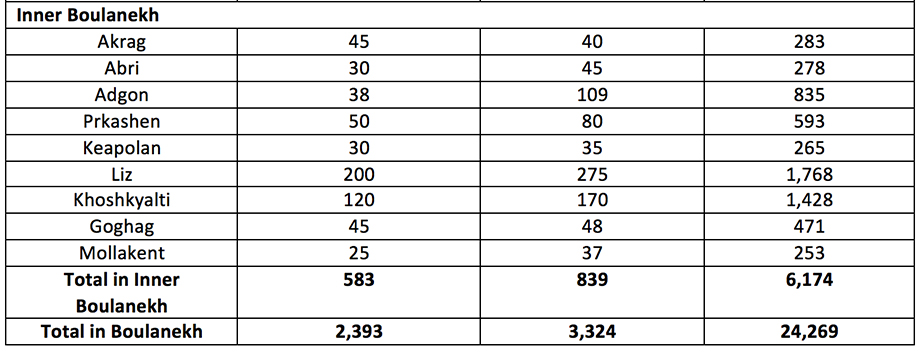Moush-Sassoun-Bitlis – Migrant Workers, Emigration and Homecomings
Author: Robert Tatoyan, 15/02/2018 (Last modified: 15/02/2018) - Translator: Simon Beugekian

-“Where are you from?”
-“From Moush.”
-“I see… So you’ve come to earn some money… What is your name?”
-“Ohan.”
-“Then may Saint Ohannes, the lord of Moush, watch over you,” exclaimed the porter, and embraced his compatriot with particular ardor.
The old man had no need to ask further questions. The fact that youth was Armenian, and from Moush, was sufficient for him. Everything else could be discussed at a later time… He knew why the people of Moush left their homes and took the road to foreign lands. He knew what they sought in the chaotic, noisy whirlpool of Istanbul… The old man knew it all, because he, too, was from Moush. He, too, had taken the same fateful path, and had left his native land for the same reasons.
Excerpt from the Gharip Mshetsi novella by Raffi [1]

The phenomena of migrant work and emigration among the Armenians of Bitlis Province
The phenomena of migrant work and emigration have a history of many centuries among the Armenians of Daron, Ottoman Armenia (the collective name for the Armenian Highlands within the borders of the Ottoman Empire, as well as the adjacent Armenian-populated areas of Lesser Hayk and Cilicia), and other regions. However, the rates of emigration accelerated rapidly after the 1877-1878 Russo-Turkish War. This was a result of the intense persecution experienced by Armenians at the hands of both the Ottoman authorities and local Kurdish tribes – massacres, both legal and extrajudicial taxation, land grabs and plunder –, as well as the deepening socio-economic crisis in the region caused by under-development, which resulted in widespread loss of land ownership and a fall in the profitability of livestock farming.
In 1875, Raffi, the prominent Armenian author and orator, described the phenomenon of Armenian emigration thus – “The chief cause behind emigration is the living conditions of Armenians in Ottoman Armenia. Every year, thousands of youth leave Van, Moush, Bitlis, Erzurum, and other provinces, heading for Istanbul, to earn a living for their families. This flow of migrants increases proportionally to the worsening of living conditions for the people in their native lands” [2].
Sarkis Pteyan, who witnessed the phenomenon first-hand, proposed the following causes for emigration – “Many lose their livelihoods for one reason or another. Some lose their land to salaf [3], others fall behind on their high-interest debts, and yet others who are farmers endure repeated catastrophes – locusts, cattle disease, drought, etc. They then find themselves in despair, and are forced to seek work elsewhere. After 1890, emigration became a much more widespread phenomenon, and was characterized in large part by an effort on the part of Armenians to flee the country to save their lives or escape persecution and plunder” [4].
There were also subjective factors that affected the rates of emigration, particularly prior to the era of Hamidian persecutions. Chief among these was the desire among Armenians to earn a larger income at a faster rate than they could by farming in their villages. “The villagers worked all year, and earned barely enough to buy clothing for their children to cover their nudity. They realized that some among them were going to Istanbul, and from there to Athens or elsewhere, and earning 10-20 kurush per day… They did not take into consideration the possibility of migrating to these cities and failing to find work, or falling ill, or encountering other serious difficulties…” wrote Sarkis Pteyan [5].
Henry Lynch, an English traveler who visited the Armenian Highland in the 1890s, wrote that the flow of migration of Armenians from the Bitlis Province varied accordingly to local factors – had the harvest been satisfactory or disastrous? Were the Kurds quarrelsome or restrained? He also mentioned that many of the villagers he encountered in Armenian areas during his travels were engaged in efforts to pay off their debts and receive permission to leave the country. Many would also relocate to the areas near the Russian border, hoping to find shelter from the Kurds [6].
The main occupation of the Armenian population in Bitlis Province was agriculture. Most Armenians who were engaged farming and husbandry were heavily indebted, and resorted to migration to escape this burden. “Almost all Armenians in Daron strain under heavy debt. It is very difficult to find any among them who is well-off. Most of their debts are owed to Turks and Kurds, and were borrowed at exorbitant interest rates”, reads a description of conditions in the 1890s [7]. This heavy debt burden on Armenian peasants is attributed to “agricultural catastrophes and losses due to plunder” [8]. Armenians resorted to migration “to free themselves from debt and with the hope of making a decent living… If they failed, they would return a few years later with whatever meager sums they had saved, or empty-handed. But they would already have accustomed themselves to life as migrant workers, and would prefer it over working the land. So they would leave again, until eventually they fell victim to the scourge of migration, like many others” [9].
The main destinations of migrants leaving Bitlis Province were the Caucasus, which was favored by Armenians from eastern parts of the province; Istanbul and Smyrna/Izmir, favored by Armenians from western parts of the province; and Cilicia and Aleppo, favored by the Armenians of Sassoun and areas south of Sassoun [10].
Migrants from Moush and Sassoun were not skilled craftsmen, and were not regarded as a high-quality workforce. Consequently, they were only qualified for the most menial of work. They mostly served as porters (hamals) in the docks of the capital city and other commercial centers, toiled as daily laborers in bakeries and water mills (in Aleppo), laid rail lines (in Cilicia), etc.
The following excerpt from Sarkis Pteyan’s memoirs provides a vivid illustration of the geographic distribution of migrants from various areas of Moush – “In many commercial centers, migrant workers from Moush dominated the ranks of the porters … In the Istanbul customs house, they made up a large proportion of the firefighters, and had achieved a certain level of infamy as belligerent characters. … Many stores employed migrants from Moush as guards. In Izmir, many Armenians merchants also hired migrants from Moush as porters and guards. Many migrants from Khaskyugh and Aragh worked in the caravan inns of Sbartali, Sivrisarian, Bakerdjian, and others. Migrants from Ardonk, Khars, and Vartenis worked in a few of the steam mills of Edirne. Many villagers worked in the port of Dedeaghach (present-day Alexandroupoli). Conditions here were more favorable for migrants to bring their families over. … Many were scattered across the cities and centers of Bulgaria – wherever they found work. … There were also a large number of migrants from Moush in the Romanian cities of Galati, Braila, and Giurgiu” [11].
As a rule, migrants lived in extreme squalor, deprived of the basic necessities of life. They lived in cellar dormitories, and often succumbed to drink, smoke, and gambling. Such conditions naturally resulted in a high rate or mortality among them. One description of the life of migrants from Sassoun in Aleppo in the early 1900s states – “The migrants for Sassoun were an unfortunate bunch, who spent their lives in misery and dirt in the insalubrious atmosphere of the bakeries. Despite their innate fitness, they soon began developing a hunch… Countless died, and those who survived wasted their earnings by competing with each other or filling the pockets of moneylenders… These miserable creatures, immersed in ignorance, also became alcoholics, smokers, and gamblers” [12].
Migrants who relocated to Aleppo from Sassoun “Lived their lives in the dark corners of cellars dug into the earth. They would age early and soon become ill”. As a result, their life expectancy did not exceed 27 [13].
Migrant workers faced a myriad of difficulties. The uncertainty and anxiety they experienced was compounded by a lack of sense of security. Many left their villages only to be attacked, arrested, killed, or injured on the road. Crossing the Russo-Turkish border was particularly fraught with hazards. Many failed to make the crossing, and spent months living as beggars in the border regions. Migrants returning home faced the danger of not only being waylaid and robbed of their earnings along the way, but also of being killed before making it home [14].
For this reason, many migrant workers were unable or unwilling to return home, adding to the number of Armenians who had permanently abandoned their homelands. Like in many other parts of the Armenian Highland under the rule of Ottoman Turkey, the preferred destinations the Armenians emigrants from Bitlis Province were the United States and the Russian Empire. The flow of Armenians from Bitlis to the USA contributed to the creation, in the mid-19th century, of Evangelical communities in the cities of Moush and Bitlis [15], and to the launching of educational initiatives by American Protestant missionaries.
Also in those years, the Evangelical community of Bitlis operated two boarding schools in the city, one designed for boys and the other for girls. The community also ran an American orphanage [16]. One of the American missionaries stationed in Bitlis wrote in a report in 1887 that many of the pupils and teachers of these schools emigrated to California in the United States, in the expectation of benefiting from the boom in the American economy and striking it rich. “The wretched, downtrodden locals are convinced that those who leave become very wealthy or that they earn unimaginably high salaries. Stories that give flight to the imagination only encourage the youth to emigrate, as do our efforts to teach them English” [17].
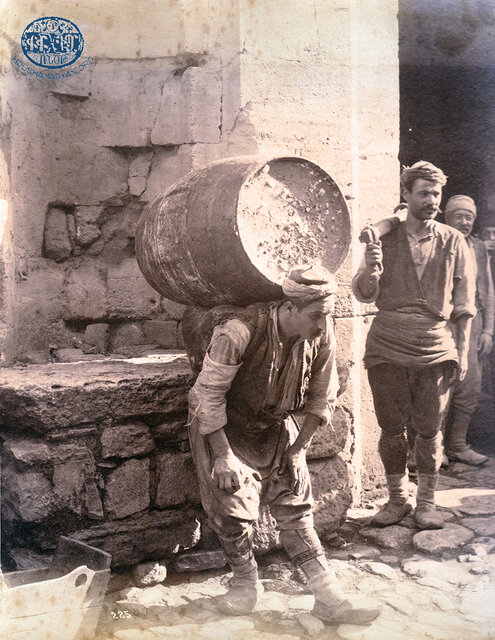
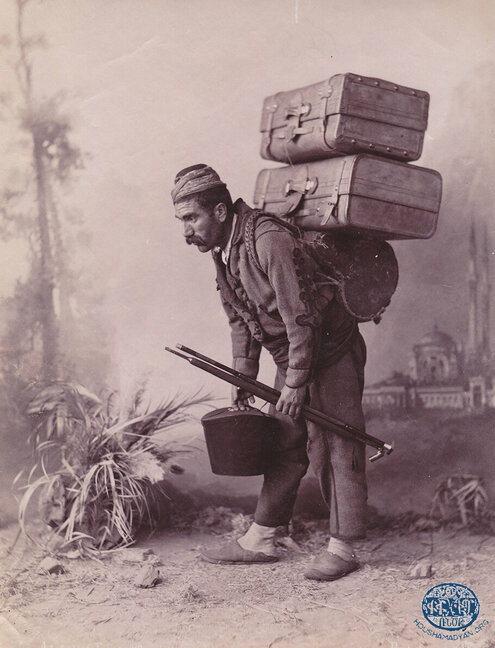
1) A hamal.Photograph probably by Sabah and Joaillier, albumen print, late 19th century (Source: Vazken Khatchig Davidian collection, London).
2) A hamal (Studio Image). Photograph by Abdullah Freres, albumen print, late 19th century (Source: Vazken Khatchig Davidian collection, London).
Sultan Abdul-Hamid’s regime worked to stanch the tide of Armenian emigration, particularly to the USA. The authorities feared that these Armenians would obtain American citizenship, and then return to the Ottoman Empire and conduct revolutionary activities, benefiting from the immunity they would enjoy by virtue of being American citizens [18]. To limit the emigration of Armenians, in 1892 the authorities introduced more stringent rules governing the provision of tezkeres (official permission slips) to Armenians allowing them to travel to the Ottoman Empire’s ports [19]. The rates of permanent emigration accelerated particularly after the 1908 Young Turk Revolution, which resulted in the easing of the constraints on travel that had been imposed by Hamidian administration [20]. At the same time, the revolution resulted in the reinstatement of constitutional rule in the country, and put an end to the reigning atmosphere of oppression. This led to a revival of public life and civic society in Western Armenian communities, and between 1908 and 1914, many Armenians who had left home, particularly those who had settled in the Russian Caucasus, began returning home to the provinces of Van, Bitlis, and Erzurum.
For thousands of Armenian migrants from the Bitlis Province, Istanbul was the principal destination. According to Hrachia Adjarian, the Armenian population of the city’s Scutari/Üsküdar neighborhood consisted, from the very beginning, of migrants from Moush [21].
In the 1890s, there were 60,000 Armenian migrants in Istanbul, who had brought with them the customary occupations and skills of their homelands. To wit, Armenians from Agn/Eğin (present-day Kemaliye) usually worked as table makers; those from Van as porters or cooks; those from Moush as porters; those from Kayseri as bricklayers and painters; those from Sivas as public bath keepers; and those from Erzincan as coffee sellers [22].
As elsewhere, many migrants from Moush who had settled in Istanbul lived in abject misery. They often fell victim to hunger, penury, and disease in the “dark and damp” cellars of the capital’s inns, baths, and coffee houses [23].
Armenian porters, as a particularly vulnerable and unprotected segment of the population, were the main targets of the massacres that broke out in Istanbul after the occupation of the Ottoman Bank on August 26-29, 1896. Many among them were killed. German reporter Magda Neumann, a contemporary, wrote – “These porters were among the fittest of the peasantry of Bitlis, Van, and Kharpert villayets. They had abandoned their native lands that had nurtured them to escape persecution by the Kurds and the plundering of Turkish officials. Every year, thousands of them hoped to make it to Istanbul, Smyrna, and other port cities on the coast of Turkey and Europe, where they resorted to heavy, physical labor to make a living… In 1896, after the massacre of the porters in Istanbul, the Turks were forced to replace them [temporarily – ed.] by Kurds” [24].
Migrants who left Moush were absent from their homes for long periods of time, sometimes six-seven years or more. Often, they sent no communication back to their families to inform them of their circumstances, leaving their wives and families in a state of uncertainty. Local Armenian churches made some efforts to remedy the situation. For example, in 1899, even the interim prelate of Moush, Senior Priest Papken Guleserian, issued a letter to Armenian migrants who had been absent from their homes for an extended period of time, appealing to them to communicate with their wives. The letter announced that if they did not comply with the request within two months, the interim prelate reserved the right to grant their wives the right to remarry [25].
No survey exists that can give a true picture of the rates of emigration of Armenians from Bitlis Province. We have figures from isolated localities, or at best, from the Armenian villages of isolated districts. For instance, Manuel Mirakhorian, who traveled across Ottoman Armenia in 1883, noted that from Khaskyugh, one of the Armenian villages of the Moush Valley, 400 people had emigrated to Istanbul (the village was home to 300 Armenian households). According to the Armenian Patriarchate’s 1913-1914 census, the number of emigrants from Khaskyugh was 380 (from 340 Armenian households) [26]. In the late 1880s, 2,000-3,000 Armenian migrants from Moush participated just in the construction of the Corinth Canal in Greece [27].
One of the questions that appeared on the survey sheet of the Armenian Patriarchate’s 1913-1914 census referred to the number of emigrants from each household. The same survey sheet asked respondents to indicate, in the “general notes” section, the countries to which household members had emigrated. The results indicated that there were 706 emigrants from the Sassoun District of Moush County. Their listed destination, almost exclusively, was Aleppo [28].
The census registered 4,449 emigrants from the Bitlis and Khlat/Ahlat districts of Bitlis Province (the census registered a total population of 35,776 in the same area. This meant that approximately 10% of the Armenian population of Bitlis and Khlat were emigrants. Since emigrants were almost always male, we can infer that 20% of the total male population of the area had emigrated). The principal destinations for emigrants from this area were listed as Russia and USA [29].
A total of 5,691 emigrants were registered from the Boulanekh/Bulanık District in the 1913-1914 census (out of a total Armenian population of 24,476). The principal destination of emigrants was listed as Russia [30].
The census registered a total of 3,026 emigrants from the Moush District (which corresponds roughly to the area of the Moush Valley), out of a total Armenian population of 65,441. Emigrants from this area headed for a myriad of internal destinations, such as Istanbul, Aleppo, Izmir, Khnous/Hınıs, and Erzurum; as well as external destination, such as Russia, USA, and Romania [31].
The census registered 405 emigrants from the Khoulp District (the village clusters of Khyank and Khoulp) of Gendj County (out of a total Armenian population of 8,316), meaning that around 10% of the area’s Armenian population had emigrated. The destination for emigrants from this area was almost exclusively Aleppo, and in some isolated cases, Erzurum and Diarbekir [32].
Based on these figures, we can infer that on the eve of the Genocide, approximately 7-8% of the Armenian population, and 14-15% of the male Armenian population of the Bitlis and Moush districts of Bitlis Province had emigrated. The sources do not indicate that emigration was widespread among the Armenians of Sghert/Siirt District, and the survey sheets of the census distributed in this district did not include questions referring to emigration. Therefore, if we include Siirt District in our calculations, we can infer that a little less than 12-13% of the Armenian population of Bitlis Province had emigrated [33].

The return of immigrants to Bitlis Province after the 1908 Young Turk Revolution
In July of 1908, a military uprising by Turkish officers in Macedonia brought about the reinstatement of the Ottoman Constitution, which had originally been proclaimed back in 1876. The Sultan’s powers were curtailed considerably, and power was assumed by the leaders of the Ittihad ve Terakki (Union and Progress) Party, who ruled the country until the end of the First World War (with an interlude from April 1912 to January 23, 1913).
Immediately after the restoration of the constitution, efforts were made to ease certain elements of the “calamitous” policies of the Sultan, and to liberalize civic society and public life. Several reforms were enacted, benefiting Armenians. The authorities lifted the state of emergency imposed on the eastern provinces, which limited the rights of Armenians to relocate from one province to the other, or from villages to cities, as well as their right to travel abroad. Armenians who had fled massacres and persecution were allowed to return. Many Armenian prisoners were released from prisons or allowed to return from exile. The hunt for Armenian fighters ceased, which allowed many to come out of hiding and return home. Armenian presence increased, as did Armenian influence in local governance bodies and other official entities [34].
Misak Pteyan, a native of Moush and a contemporary of these events, described what followed the 1908 restoration of the constitution with some hyperbole – “The entire Armenian population of Moush drew a deep breath. There would be no more plunder, no illegal taxes, no excesses on the part of the gendarmes, no more pillaging of villages by mültezims [35], no more khafir [36] taxes… The Armenian nation, which had been in its death throes, was rising from the ashes. Thanks to their diligence, resilience, and rigor, less than a year or two later, Armenians were masters of all” [37].
1) A street view of Aleppo (Source: Ernest Chantre, "Van Beyroeth naar Tiflis", De Aarde en haar Volken, Haarlem, 1890).
2) Istanbul: A porter surrounded by street dogs. Photograph by Abdullah Freres, late 19th century, postcard by Max Fruchtermann (Source: Vazken Khatchig Davidian collection, London).
During the Hamidian years, the authorities’ willingness to use the Kurds to suppress the Armenian population, which effectively sanctioned all brutality committed by the Kurds against Armenians, had allowed Kurdish aghas to appropriate much of the arable land belonging to Armenians. They had Kurdified many Armenian settlements, and had instituted racketeering schemes in parts of Bitlis Province. After the Young Turk Revolution, the Kurds, as former supporters of the Hamidian regime, lost much of the immunity they once enjoyed. Kurdish oppression of the area’s Armenians eased substantially.
As a result of these changes, Armenians who had emigrated to the Balkans and the Caucasus began returning home. According to the figures quote by V. Shirgov, the Russian consul to Tbilisi, in his September 1909 report, 5,000 emigrants had returned to Daron in 1909. The consul’s report also mentioned that the flow of Armenians returning from the Russian Empire to the Ottoman Empire was increasing [38]. According to figures published in the press, by September of 1909, 20,000-25,000 Armenians from Van or Moush had returned home [39].
Armenians who had become internal refugees to escape the persecution of the Kurds, meaning those who had fled to neighboring provinces and districts, also began returning home. One of the contemporaries who registered this phenomenon of homecoming was Arshag Safrasdian, who traveled across the villages of the Khoyt-Prnashen area in September 1910. Safrasdian was the deputy British consul to Diarbekir [40]. In his notes, he wrote that in 1907 there were virtually no Armenians left in the Keghonk (Kelonk) village of the Khoyt-Prnashen area, but that in 1910, at the time of his visit, the village was relatively prosperous and flourishing. He was told by the Armenian elder of the village that four more Armenian families who had fled to Khnous were expected to return home [41].
The Lorantsor (Lotetsor) village of the same area was also recovering its lost population. In 1907, when Safrasdian had visited, the village had been home to a total of seven Armenian households. In 1910, the number of Armenian households had reached 23. “Now that the constitution has been restored, many refugees have returned, and many more are expected to return,” Safrasdian wrote [42].
However, in October of 1912, Bishop Nerses Kharakhanian, the spiritual leader of the Prelacy of Daron, provided the following description of the realities for the Armenian population of Daron – “The restoration of the constitution was welcomed with much excitement by all Armenians, but the results have fallen short of the people’s expectations. It’s true that for a year or two there was a measure of peace and some sense of security, and travel became easier, but no radical reforms were implemented. There are still dark corners of the country, like Sassoun, Khoyt, Prnashen, Modgan, etc., that continue to be oppressed as they have long been, and where the level of oppression has even increased. This came in response to those who, encouraged by the constitutional reforms, agitated to topple the established order. Killings, kidnappings, and plunder continued in these areas, and the guilty parties remained unpunished” [43].
Among the most critical challenges faced by Armenians returning to Bitlis Province was the issue of land. They had to reclaim their lands that had been taken over by Turkish and Kurdish landowners during the Hamidian years, using different means. “During the years of Hamidian despotism Armenians were not only plundered, they not only gave thousands of honored martyrs, but also they lost their lands and fields to Turkish and Kurdish beks and aghas, who were encouraged by the administration’s exterminatory attitude towards Armenians. There was not a single village that had been spared this scourge … Particularly poignant is the situation of those Armenians who had fled sword and fire to escape the region, most of them finding shelter on Russian land. Hearing of the constitutional restoration, they had returned home. To this day, they have not been able to recover their lands, and have been condemned to live as beggars. They have no fields, and have no homes, but their tears move nobody to pity,” wrote Bishop Nerses Kharakhanian [44].
Despite the fact that many of the issues facing Ottoman Armenians remained unresolved, the simple fact that the central authorities had eased their systematic persecution of Armenians had a favorable effect on the Armenian population of Bitlis Province and its growth. We have obtained an exceptional source that provides figures on the Armenian population of the Moush, Malazgird, and Boulanekh districts of Moush. This document consists of two lists prepared by Nazaret Mardirosian, secretary of the Moush Prelacy, providing the Armenian population of aforementioned areas at the start of 1909 and end of 1914-start of 1915, respectively. As can be seen in Table 1, while in 1909 there were 7,595 Armenian households in the 90 Armenian-populated settlements in the Moush Valley, in 1914 the number of households had risen to 9,516, for a total Armenian population of 82,361. Therefore, according to Mardirosian’s figures, the Armenian population of the Armenian-populated settlements in the Moush Valley grew by 25% in six years, or an average growth of more than 4% per year (if we take the average number of people in a household in 1914, and assume that the same figure was valid for households in 1909, we can estimate the total Armenian population of Moush Valley in 1909 was 65,735) [45].
Likewise, according to N. Mardirosian’s figures, in the 34 settlements listed in the Malazgird District, there were 1,082 Armenians households in 1909, and 1,305 households in 1914, for a total Armenian population of 10,808 (20.6% increase in the number of households, or 3.4% per year (see Table 2)) [46]. In the case of Boulanekh, the number of Armenian households in the 24 listed settlements grew from 2,393 in 1909 to 3,324 in 1914, growing by 38.9% or approximately 6.5% per year (see Table 3) [47]. Naturally, such accelerated growth of population was due not only to natural population growth, but also the return of migrants [48].
The Russo-Turkish agreement was signed on February 8, 1914. It obligated the Ottoman administration to implement reforms in the Empire’s Armenian-populated eastern provinces. The implementation of this agreement would naturally have led to improvements in the status and lives of Armenians, which would encourage the return of Armenian emigrants to Bitlis Province. But the anticipated did not materialize. The agreement was rescinded by the Young Turks immediately upon the start of the First World War. This cancellation of the agreement heralded the Ottoman authorities’ decision to implement the final solution of the Armenian problem by exterminating the Empire’s Armenian population.
Table 1. The Armenian population of the Moush District in 1909 and in 1914, according to Nazaret Mardirosian
Table 2. The Armenian population of the Manazgerd District in 1909 and in 1914, according to Nazaret Mardirosian
Table 3. The Armenian population of the Boulanekh/Bulanik District in 1909 and in 1914, according to Nazaret Mardirosian

- [1] Artsakank Literary and Political Weekly Journal, Tbilisi, August 10, 1886, N. 30, page 388.
- [2] Mshag, January 16, 1875, N. 2.
- [3] “Salaf” – land mortgage. For more on Salaf, see Kegham Der-Garabedian’s Hoghayin Hartse Hayapnag Kavarnerou metch, Istanbul, 1911, pages 28-29.
- [4] Sarkis and Misag Pteyan, Harazad Badmutyun Darono, edited by Aghan Daronetsi, Cairo, Sahag-Mesrob Printing House, 1962, page 29.
- [5] Ibid., page 28.
- [6] H.F.B. Lynch, Armenia: Travels and Studies, Volume II: The Turkish Provinces, London, Longmans, Green, and Co., 1901, page 426.
- [7] “Msho Ashkhar”, Louma Literary Review, Tbilisi, 1899, N. 1, page 122.
- [8] Ibid.
- [9] Ibid., page 123.
- [10] For details on the emigration of Sassoun Armenians to Aleppo, see Varti Keshishian, “Sassoun-Aleppo historical links. Sassoun Armenians in Aleppo”, Haigazian Hayakidagan Hantes, Volume 24, Beirut, 2004, pages 93-138. Also see Vahram L. Shemassian, “The Sasun Pandukhts in Nineteenth-Century Aleppo”, in Armenian Baghesh/Bitlis and Taron/Mush, R. Hovannisian (ed.), Mazda Publishers, Inc., 2001, pages 175-189.
- [11] Sarkis and Misag Pteyan, Harazad Badmutyun Darono, pages 27-28.
- [12] A.M. Sevian (Iskender Karadjian), “The past and present of the Armenian community in Aleppo”, Arevelyan Mamoul, Smyrna, 36th year, 1906, June 14, n. 25, page 614. Quoted by Varti Keshishian, “Sassoun-Aleppo historical links”, page 128.
- [13] Father Mgrdich Mouradian, “Sassoun Armenians in Aleppo”, Dadjar, Istanbul, 1910, n. 28, page 644. Quoted by Varti Keshishian, “Sassoun-Aleppo historical links”, page 128.
- [14] Stepan Boghosian, Badmakidagan Ousoumnasirutyunner, Hayots Tseghasbanutyan Badmutyun, I, Yerevan, Yerevan State University, 2008, pages 315-316.
- [15] In 1855 in Moush (Garo Sassouni, Badmutyun Daroni Ashkharki, Beirut, Central Executive Board of the Daron-Darouperan Patriotic Union, Sevan Publishers, 1956, page 304); and in 1864 in Bitlis (R. Mirak, Torn Between Two Lands, Armenians in America, 1890 to World War I, Harvard University press, Cambridge, Massachusetts, 1983, page 42).
- [16] For a list of educational institutions, see Houshartsan Hay Avedaranaganats yev Avedaranagan Yegeghetsvo (Knnagan Dzanotoutyounnerov), Rev. G.B. Adanalian, Fresno, California, 1952, pages 472-474.
- [17] Mirak, Torn Between Two Lands, page 42.
- [18] Ibid., page 43.
- [19] Ibid., page 46.
- [20] Sarkis and Misag Pteyan, Harazad Badmutyun Darono, page 28.
- [21] Hrachia Ajarian, Hay Kaghtaganoutyan Badmutyun, Yerevan, “Zankag-97”, 2002, page 631.
- [22] Ibid.; Sarkis and Misag Pteyan, Harazad Badmutyun Darono, page 27.
- [23] Hay Kaghtashkharhi Badmutyun (Michnatarits minchev 1920), Volume 2, Yerevan, Kidutyun Publishers, 2003, page 117.
- [24] Magda Naiman, Armenians, 1991, pages 107-108. Quoted in Hay Kaghtashkharhi Badmutyun…, page 116.
- [25] “Rejected spinsters”, Arevelyan Mamoul, Smyrna, November 15, 1899, N. 22. The issue was also address in the early 1900s in an article written by Kegham Der-Garabedian, a native of Moush, titled “The abandoned wives of Moush emigrants” (Dzaghig newspaper, Istanbul, 1900, N. 112, 113).
- [26] Manuel Mirakhorian, Ngarakragan Oughevorutyun i Hayapnag Kavars Arevelyan Dadjgasdani, Part A., Istanbul, 1884, pages 45-46; AGBU Nubarian Library Archives, APC/BNu, DOR 3/3, f. 58. According to other figures that circulated in the media in 1913, the number of emigrants who had left Khaskugh was around 600, from a total of 400 Armenian households (Hampartsoum Arakelian, “Census of the Armenian population in Turkey”, Aror Monthly Review: Literacy, Scientific-Ethnographic, and Pacifistic, Year IV, December 1913, page 77).
- [27] Sarkis and Misag Pteyan, Harazad Badmutyun Darono, page 27.
- [28] AGBU Nubarian Library Archives, APC/BNu, DOR 3/3, ff. 45-48. For comparison, according to the figures of the 1880 census commissioned by the Armenian Patriarchate, there were 303 Armenian emigrants from Sassoun in Aleppo (Varti Keshishian, “Sassoun-Aleppo historical links…”, page 114). In 1910, Father Mgrdich Mouratian, a native of Sassoun, wrote an article titled “Armenians from Sassoun in Aleppo” that there were 4,000 emigrants from Sassoun in Aleppo and the surrounding area (ibid., page 127).
- [29] AGBU Nubarian Library Archives, APC/BNu, DOR 3/3, ff. 48-52.
- [30] AGBU Nubarian Library Archives, APC/BNu, DOR 3/3, ff. 53.
- [31] AGBU Nubarian Library Archives, APC/BNu, DOR 3/3, ff. 55-59.
- [32] AGBU Nubarian Library Archives, APC/BNu, DOR 3/3, ff. 61.
- [33] Ibid. According to the calculations of Raymond Kevorkian, based on the data provided by the Armenian Patriarchate’s 1913-1914 census, there were a total of 15,307 Armenian migrants, out of a total population of 196,840, in the Bitlis and Moush districts of Bitlis Province (Raymond H. Kevorkian and Paul B. Paboudjian, Les Arméniens dans l’Empire Ottoman à la Veille du Génocide, Paris, Editions d’Art et d’Histoire, 1992, pages 59-60). Based on these calculations, 7% of the total population, and around 14% of the male population, had emigrated.
- [34] A.S. Hamparian, Yeridtourkeri Azkayin ou Hoghayin Kaghakaganoutyune yev Azadakragan Sharjoumnern Arevmdyan Hayasdanoum, Yerevan, published by the Science Academy of the Armenian SSR, 1979, pages 20-21; Vahram Paypourtian, Osmanian Gaysroutian Badmutyun, Yerevan, published by Yerevan State University, 2011, page 608.
- [35] Individuals who were sanctioned by the Ottoman authorities to collect taxes from certain areas.
- [36] The term khafir comes from the Arab khafir or ghafir, which means guardian. The fact was that sometimes villagers would appeal to the aghas or Kurdish chieftains to protect them from attacks and raids, thus taking on the obligation of paying for this protection; while in other cases, the aghas would simply proclaim that they were the defenders of the villagers, and would force the latter to pay taxes for this supposed protection (A.S. Hamparian, “Social terminology in Western Armenia (19th century – early 20th century), Badmakidagan Hantes, 1992, N. 2-3, pages 137-138).
- [37] Sarkis and Misag Pteyan, Harazad Badmutyun Darono, page 269.
- [38] Ibid. (Archive of Foreign Policy of the Russian Empire, f. “Political Archives”, 1909, c. 482, k. 1644, page 52).
- [39] “Vatan is calling to you”, Horizon, Tbilisi, September 4, 1909, N. 28.
- [40] A. Safrasdian, “The Khoyt-Prnashen districts: descriptions of a journey”, Hantes Amsoria, Vienna, 1933, Year 47, September-October, page 612 – “Since the constitutional reforms, the ashirets of Shegots and Khoutets were more restrained in their repressions in this area [The Taghventsor Armenian-populated settlement of Khoyt-Prnashen – ed.] and surrounding Armenian villages, and those who had left the village and had been scattered elsewhere were still returning to their native lands”. However, we must note that the raids on and the plundering of Armenian villages by Kurds had not ceased completely. A. Safrasdian provides several examples of such events that took place after the constitutional reforms.
- [41] Ibid., page 613 (see the information provided on the Khoyt-Prnashen area for figures regarding the Armenian population of village of Kelonk).
- [42] Ibid., page 615. The author also mentions the phenomenon of the return of emigrants when writing about the Taghavank and Shamyank settlements of Khoyt-Prnashen (A. Safrasdian, “The Khoyt-Prnashen districts: descriptions of a journey”, Hantes Amsoria, Vienna, 1934, Year 49, May-July, page 308).
- [43] “The land issue in Daron (excerpts from a report)”, Ararat, Echmiadzin, 1913, Year 47, January, Volume A, page 90; H.M. Boshosian, Sassouni Badmutyun, Yerevan, Armenia Publishers, 1985, page 288.
- [44] “The land issue in Daron…”, Ararat, pages 90-91. For details regarding the Armenians demands for land reforms after the Young Turk Revolution, see Kegham Der-Garabedian, Hoghayin Hartse Hayapnag Nahanknerou Mech (for specific details on Bitlis Province, see pages 8-28). Also see H.M. Boghosian, Sassouni Badmutyun, pages 283-290; and A.S. Hamparian Yeridtourkeri Azkayin yev Hoghayin Kaghakaganoutyoune…, pages 48-105.
- [45] For N. Mardirosian’s statistics on Moush District in 1909, see A-To, Vani, Bitlisi, yev Erzurumi Vlayetner. Ousoumnasiroutyan mi Ports ayt Yergri Ashkharhakragan, Vidjagakragan, Iravagan, yev Dndesagan Troutyan, Yerevan, Cultura Press, pages 104-107. For statistics from 1914, see Van-Dosb Political, Literary and Society Weekly Magazine, February 28, 1916, N. 14, page 7.
- [46] For N. Mardirosian’s statistics on Manazgerd District in 1909, see A-To, Vani, Bitlisi, yev Erzurumi Vlayetner…, pages 149-150. For statistics from 1914, see Van-Dosb, 1916, N. 14, page 7.
- [47] For N. Mardirosian’s statistics on Boulanekh District in 1909, see A-To, Vani, Bitlisi, yev Erzurumi Vlayetner…, page 146. For statistics from 1914, see Van-Dosb, 1916, N. 14, page 7.
- [48] Still, we cannot rule out the possibility of N. Mardirosian having underestimated the Armenian population of 1909 to a certain extent.
